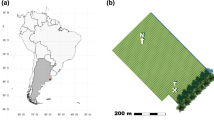Abstract
The flux contribution of coherent structures to the total exchange of energy and matter is investigated in a spruce canopy of moderate density in heterogeneous, complex terrain. The study deploys two methods of analysis to estimate the coherent exchange: conditional averages in combination with wavelet analysis, and quadrant analysis. The data were obtained by high-frequency single-point measurements using sonic anemometers and gas analysers at five observation heights above and within the canopy and subcanopy, and represent a period of up to 2.5 months. The study mainly addresses the momentum transfer and exchange of sensible heat throughout the roughness sublayer, while results are provided for the exchange of carbon dioxide and water vapour above the canopy.
The magnitude of the flux contribution of coherent structures largely depends on the method of analysis, and it is demonstrated that these differences are attributed to differences in the sampling strategy between the two methods. Despite the differences, relational properties such as sweep and ejection ratios and the variation of the flux contribution with height were in agreement for both methods. The sweep phase of coherent structures is the dominant process close to and within the canopy, whereas the ejections gain importance with increasing distance to the canopy. The efficiency of the coherent exchange in transporting scalars exceeds that for momentum by a factor of two. The occurrence of coherent structures results in a flux error less than 4% for the eddy-covariance method. Based on the physical processes identified from the analysis of the ejection and sweep phases along the vertical profile in the roughness sublayer, a classification scheme for the identification of exchange regimes is developed. This scheme allows one to estimate the region of the canopy participating in the exchange of energy and matter with the above-canopy air under varying environmental conditions.
Similar content being viewed by others
References
Antonia R, Browne L, Bisset D, Fulachier L (1987) A description of the organized motion in the turbulent far wake of a cylinder at low Reynolds numbers. J Fluid Mech 184:423–444
Antonia RA (1981) Conditional sampling in turbulence measurements. Ann Rev Fluid Mech 13:131–156
Bergström H, Högström U (1989) Turbulent exchange above a pine forest. II. Organized structures. Boundary-Layer Meteorol 49:231–263
Cava D, Giostra U, Siqueira M, Katul G (2004) Organised motion and radiative perturbations in the nocturnal canopy sublayer above an even-aged pine forest. Boundary-Layer Meteorol 112: 129–157
Collineau S, Brunet Y (1993a) Detection of turbulent coherent motions in a forest canopy. Part I: Wavelet analysis. Boundary-Layer Meteorol 65:357–379
Collineau S, Brunet Y (1993b) Detection of turbulent coherent motions in a forest canopy Part II: Time-scales and conditional averages. Boundary-Layer Meteorol 66:49–73
Finnigan J (2000) Turbulence in plant canopies. Ann Rev Fluid Mech 32:519–571
Finnigan JJ (1979) Turbulence in waving wheat. II. Structure of momentum transfer. Boundary-Layer Meteorol 16:213–236
Gao W, Shaw RH, Paw UKT (1989) Observation of organized structure in turbulent flow within and above a forest canopy. Boundary-Layer Meteorol 47:349–377
Gerstberger P, Foken T, Kalbitz K (2004) The Lehstenbach and Steinkreuz chatchments in NE Bavaria, Germany. In: Matzner E. (eds) Biogeochemistry of forested catchments in a changing environment: ecological studies, vol 172. Springer, Heidelberg, pp 15–41
Kaimal JC, Finnigan JJ (1994) Atmospheric boundary layer flows: their structure and measurement. Oxford University Press, New York, 289 pp
Katul G, Goltz SM, Hsieh CI, Cheng Y, Mowry F, Sigmon J (1995) Estimation of surface heat and momentum fluxes using the flux-variance method above uniform and non-uniform terrain. Layer Meteorol 80:249–282
Katul G, Hsieh C, Ellsworth D, Oren R, Phillips N (1996) Latent and sensible heat fluxes from a uniform pine forest using surface renewal and flux variance methods. Boundary-Layer Meteorol 80:249–282
Katul G, Kuhn G, Schieldge J, Hsieh C-I (1997) The ejection-sweep character of scalar fluxes in the unstable surface layer. Boundary-Layer Meteorol 83:1–26
Lu SS, Willmarth WW (1973) Measurements of the structure of Reynolds stress in a turbulent boundary layer. J Fluid Mech 60:481–512
Maitani T, Shaw RH (1990) Joint probability analysis of momentum and heat fluxes at a deciduous forest. Boundary-Layer Meteorol 52:283–300
Poggi D, Porporato A, Ridolfi L, Albertson JD, Katul GG (2004) The effect of vegetation density on canopy sub-layer turbulence. Boundary-Layer Meteorol 111:565–587
Raupach MR (1981) Conditional statistics of Reynolds stress in rough-wall and smooth-wall turbulent boundary layers. J Fluid Mech 108:363–382
Raupach MR, Finnigan JJ, Brunet Y (1996) Coherent eddies and turbulence in vegetation canopies: the mixing-layer analogy. Boundary-Layer Meteorol 78:351–382
Ruppert J, Thomas C, Foken T (2006) Scalar similarity for relaxed eddy accumulation methods. Boundary-Layer Meteorol DOI 10.1007/s10546-005-9043-3
Shaw RH, Tavangar J, Ward DP (1983) Structure of the Reynolds stress in a canopy layer. J Clim Appl Meteorol 22:1922–1931
Thomas C, Foken T (2005) Detection of long-term coherent exchange over spruce forest using wavelet analysis. Theor Appl Climatol 80:91–104
Thomas C, Foken T (2007) Organised motion in a tall spruce canopy: temporal scales, structure spacing and terrain effects. Boundary-Layer Meteorol DOI 10.1007/s10546-006-9087
Thomas C, Mayer J-C, Meixner F, Foken T (2006) Analysis of low-frequency turbulence above tall vegetation using a Doppler sodar. Boundary-Layer Meteorol 119:563–587
Wallace JM, Eckelmann H, Brodkey RS (1972) The wall region in turbulent shear flow. J Fluid Mech 54:39–48
Wichura B, Ruppert J, Delany AC, Buchmann N, Foken T (2004) Structure of carbon dioxide exchange processes above a spruce forest. In Matzner E (ed) Biogeochemistry of forested catchments in a changing environment: ecological Studies, Ecological Studies, vol. 172. Springer Berlin, Heidelberg, pp 161–176
Author information
Authors and Affiliations
Corresponding author
Rights and permissions
About this article
Cite this article
Thomas, C., Foken, T. Flux contribution of coherent structures and its implications for the exchange of energy and matter in a tall spruce canopy. Boundary-Layer Meteorol 123, 317–337 (2007). https://doi.org/10.1007/s10546-006-9144-7
Received:
Accepted:
Published:
Issue Date:
DOI: https://doi.org/10.1007/s10546-006-9144-7




